Evaluating Legal Relationships: Regina Plc's Expansion into Brazil
VerifiedAdded on 2020/04/21
|13
|3738
|472
Report
AI Summary
This report examines the legal relationships available to Regina Plc, a French tourism company, as it seeks to expand its business into Brazil. The report evaluates three options: agency, distributor, and joint venture, assessing their suitability based on factors such as control, liability, and brand value. After analyzing each option, the report determines that a joint venture is the most viable choice for Regina Plc. The report then outlines the key terms that should be included in the joint venture agreement with XYZ Incorporated to ensure a strong and successful partnership, minimizing potential ambiguities. The analysis highlights the importance of understanding the nuances of international business and the benefits of carefully selecting the appropriate legal structure for market entry, ultimately recommending a joint venture strategy for Regina Plc's expansion into the Brazilian tourism market.

Running Head: LEGAL RELATIONSHIPS
Economics and International Business Law
Economics and International Business Law
Paraphrase This Document
Need a fresh take? Get an instant paraphrase of this document with our AI Paraphraser
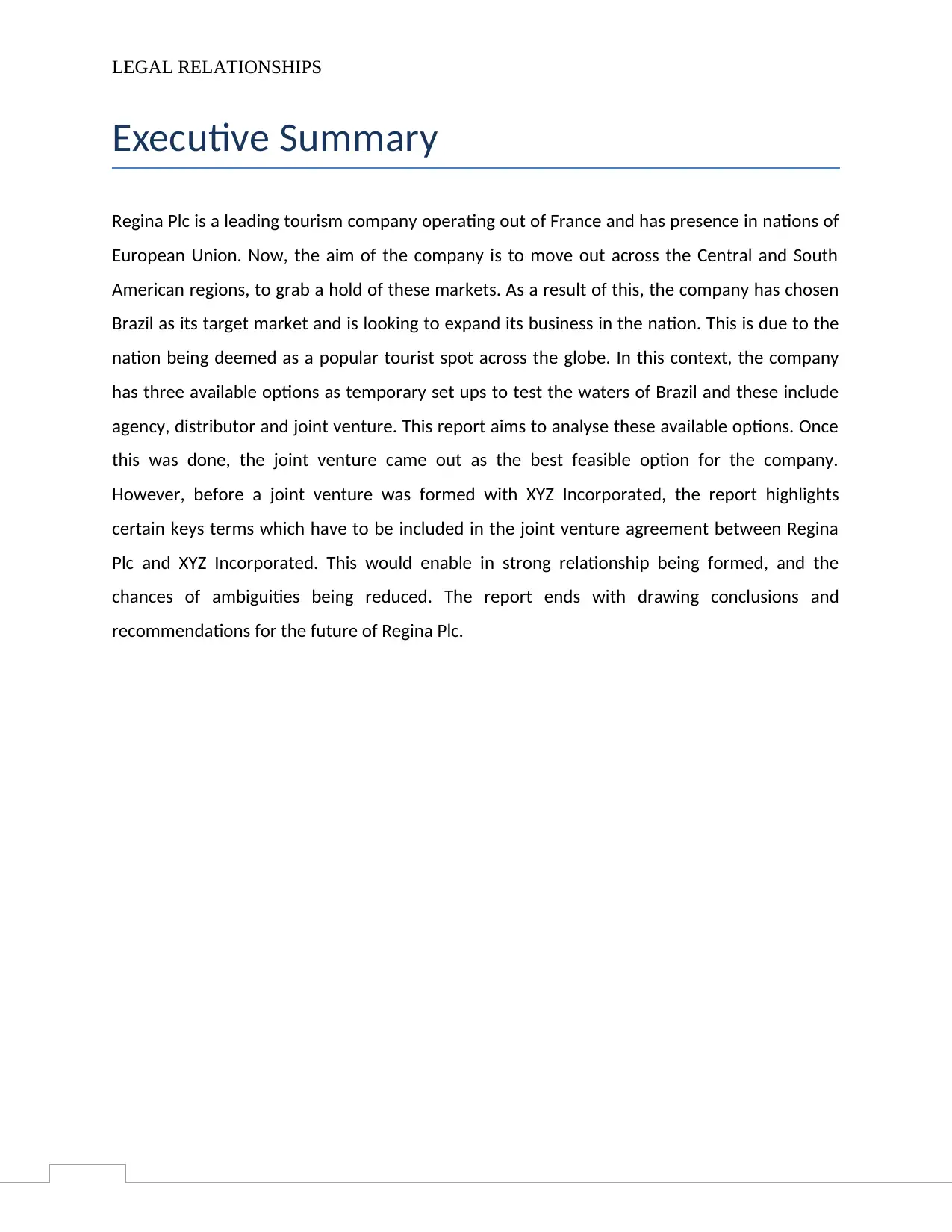
LEGAL RELATIONSHIPS
Executive Summary
Regina Plc is a leading tourism company operating out of France and has presence in nations of
European Union. Now, the aim of the company is to move out across the Central and South
American regions, to grab a hold of these markets. As a result of this, the company has chosen
Brazil as its target market and is looking to expand its business in the nation. This is due to the
nation being deemed as a popular tourist spot across the globe. In this context, the company
has three available options as temporary set ups to test the waters of Brazil and these include
agency, distributor and joint venture. This report aims to analyse these available options. Once
this was done, the joint venture came out as the best feasible option for the company.
However, before a joint venture was formed with XYZ Incorporated, the report highlights
certain keys terms which have to be included in the joint venture agreement between Regina
Plc and XYZ Incorporated. This would enable in strong relationship being formed, and the
chances of ambiguities being reduced. The report ends with drawing conclusions and
recommendations for the future of Regina Plc.
Executive Summary
Regina Plc is a leading tourism company operating out of France and has presence in nations of
European Union. Now, the aim of the company is to move out across the Central and South
American regions, to grab a hold of these markets. As a result of this, the company has chosen
Brazil as its target market and is looking to expand its business in the nation. This is due to the
nation being deemed as a popular tourist spot across the globe. In this context, the company
has three available options as temporary set ups to test the waters of Brazil and these include
agency, distributor and joint venture. This report aims to analyse these available options. Once
this was done, the joint venture came out as the best feasible option for the company.
However, before a joint venture was formed with XYZ Incorporated, the report highlights
certain keys terms which have to be included in the joint venture agreement between Regina
Plc and XYZ Incorporated. This would enable in strong relationship being formed, and the
chances of ambiguities being reduced. The report ends with drawing conclusions and
recommendations for the future of Regina Plc.
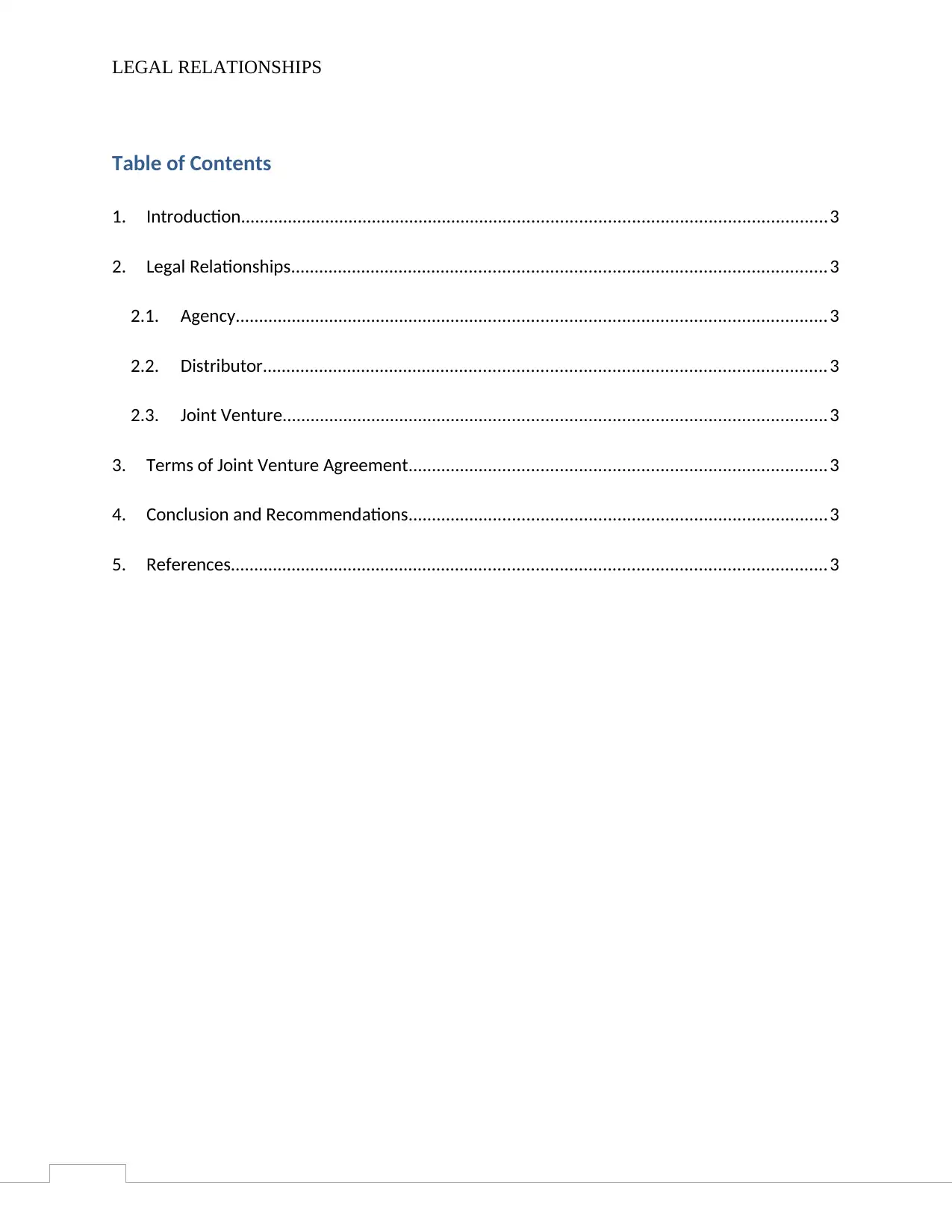
LEGAL RELATIONSHIPS
Table of Contents
1. Introduction............................................................................................................................3
2. Legal Relationships.................................................................................................................3
2.1. Agency.............................................................................................................................3
2.2. Distributor....................................................................................................................... 3
2.3. Joint Venture...................................................................................................................3
3. Terms of Joint Venture Agreement........................................................................................3
4. Conclusion and Recommendations........................................................................................3
5. References..............................................................................................................................3
Table of Contents
1. Introduction............................................................................................................................3
2. Legal Relationships.................................................................................................................3
2.1. Agency.............................................................................................................................3
2.2. Distributor....................................................................................................................... 3
2.3. Joint Venture...................................................................................................................3
3. Terms of Joint Venture Agreement........................................................................................3
4. Conclusion and Recommendations........................................................................................3
5. References..............................................................................................................................3
⊘ This is a preview!⊘
Do you want full access?
Subscribe today to unlock all pages.

Trusted by 1+ million students worldwide
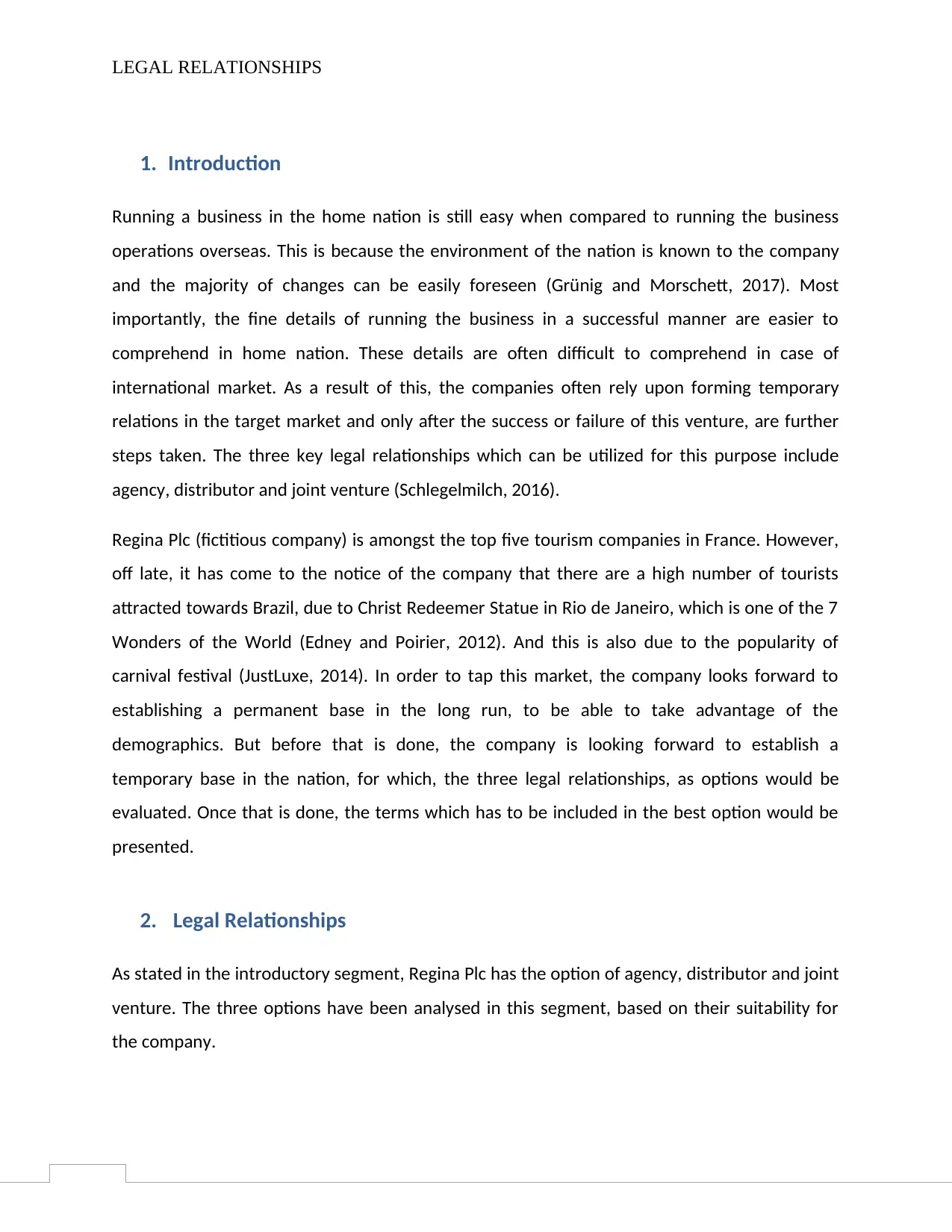
LEGAL RELATIONSHIPS
1. Introduction
Running a business in the home nation is still easy when compared to running the business
operations overseas. This is because the environment of the nation is known to the company
and the majority of changes can be easily foreseen (Grünig and Morschett, 2017). Most
importantly, the fine details of running the business in a successful manner are easier to
comprehend in home nation. These details are often difficult to comprehend in case of
international market. As a result of this, the companies often rely upon forming temporary
relations in the target market and only after the success or failure of this venture, are further
steps taken. The three key legal relationships which can be utilized for this purpose include
agency, distributor and joint venture (Schlegelmilch, 2016).
Regina Plc (fictitious company) is amongst the top five tourism companies in France. However,
off late, it has come to the notice of the company that there are a high number of tourists
attracted towards Brazil, due to Christ Redeemer Statue in Rio de Janeiro, which is one of the 7
Wonders of the World (Edney and Poirier, 2012). And this is also due to the popularity of
carnival festival (JustLuxe, 2014). In order to tap this market, the company looks forward to
establishing a permanent base in the long run, to be able to take advantage of the
demographics. But before that is done, the company is looking forward to establish a
temporary base in the nation, for which, the three legal relationships, as options would be
evaluated. Once that is done, the terms which has to be included in the best option would be
presented.
2. Legal Relationships
As stated in the introductory segment, Regina Plc has the option of agency, distributor and joint
venture. The three options have been analysed in this segment, based on their suitability for
the company.
1. Introduction
Running a business in the home nation is still easy when compared to running the business
operations overseas. This is because the environment of the nation is known to the company
and the majority of changes can be easily foreseen (Grünig and Morschett, 2017). Most
importantly, the fine details of running the business in a successful manner are easier to
comprehend in home nation. These details are often difficult to comprehend in case of
international market. As a result of this, the companies often rely upon forming temporary
relations in the target market and only after the success or failure of this venture, are further
steps taken. The three key legal relationships which can be utilized for this purpose include
agency, distributor and joint venture (Schlegelmilch, 2016).
Regina Plc (fictitious company) is amongst the top five tourism companies in France. However,
off late, it has come to the notice of the company that there are a high number of tourists
attracted towards Brazil, due to Christ Redeemer Statue in Rio de Janeiro, which is one of the 7
Wonders of the World (Edney and Poirier, 2012). And this is also due to the popularity of
carnival festival (JustLuxe, 2014). In order to tap this market, the company looks forward to
establishing a permanent base in the long run, to be able to take advantage of the
demographics. But before that is done, the company is looking forward to establish a
temporary base in the nation, for which, the three legal relationships, as options would be
evaluated. Once that is done, the terms which has to be included in the best option would be
presented.
2. Legal Relationships
As stated in the introductory segment, Regina Plc has the option of agency, distributor and joint
venture. The three options have been analysed in this segment, based on their suitability for
the company.
Paraphrase This Document
Need a fresh take? Get an instant paraphrase of this document with our AI Paraphraser
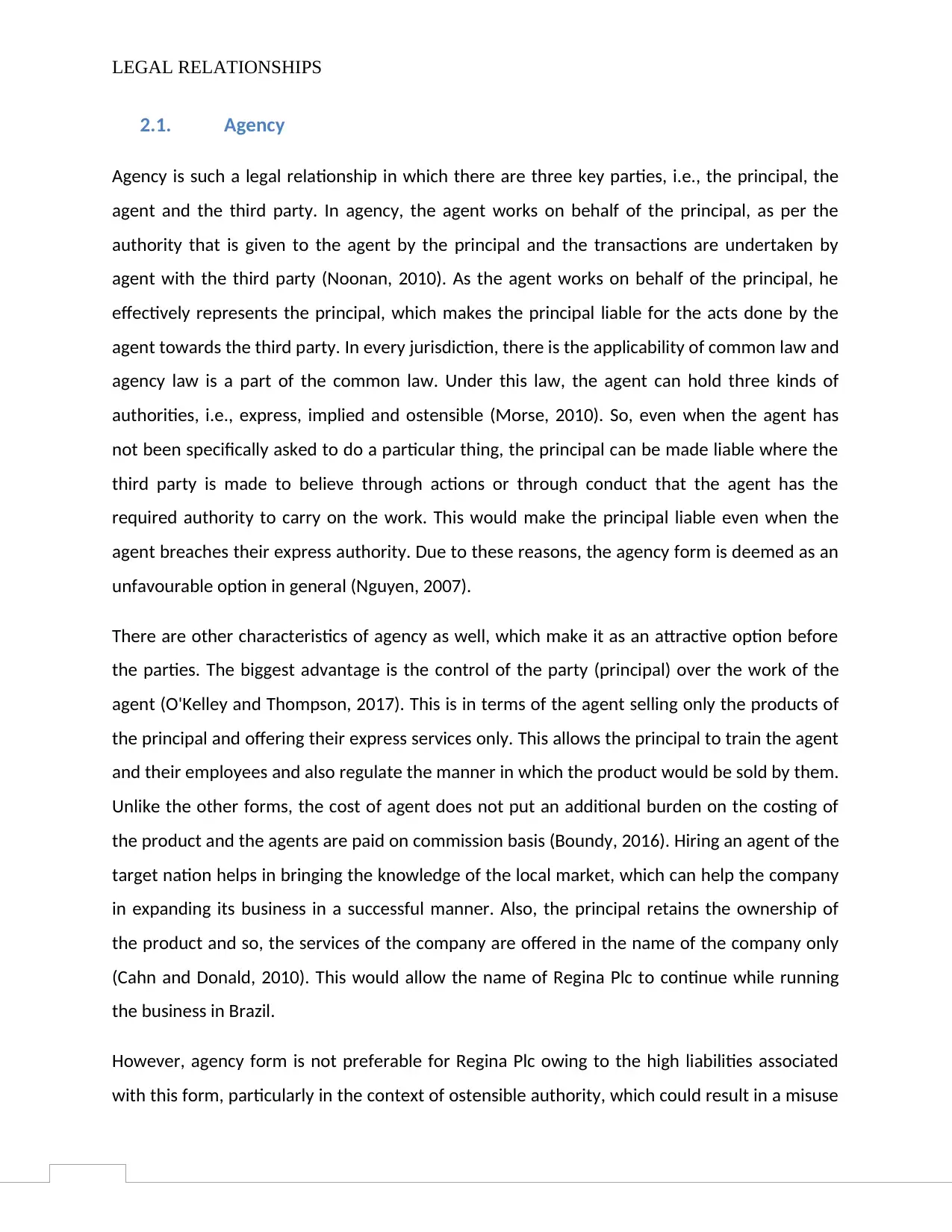
LEGAL RELATIONSHIPS
2.1. Agency
Agency is such a legal relationship in which there are three key parties, i.e., the principal, the
agent and the third party. In agency, the agent works on behalf of the principal, as per the
authority that is given to the agent by the principal and the transactions are undertaken by
agent with the third party (Noonan, 2010). As the agent works on behalf of the principal, he
effectively represents the principal, which makes the principal liable for the acts done by the
agent towards the third party. In every jurisdiction, there is the applicability of common law and
agency law is a part of the common law. Under this law, the agent can hold three kinds of
authorities, i.e., express, implied and ostensible (Morse, 2010). So, even when the agent has
not been specifically asked to do a particular thing, the principal can be made liable where the
third party is made to believe through actions or through conduct that the agent has the
required authority to carry on the work. This would make the principal liable even when the
agent breaches their express authority. Due to these reasons, the agency form is deemed as an
unfavourable option in general (Nguyen, 2007).
There are other characteristics of agency as well, which make it as an attractive option before
the parties. The biggest advantage is the control of the party (principal) over the work of the
agent (O'Kelley and Thompson, 2017). This is in terms of the agent selling only the products of
the principal and offering their express services only. This allows the principal to train the agent
and their employees and also regulate the manner in which the product would be sold by them.
Unlike the other forms, the cost of agent does not put an additional burden on the costing of
the product and the agents are paid on commission basis (Boundy, 2016). Hiring an agent of the
target nation helps in bringing the knowledge of the local market, which can help the company
in expanding its business in a successful manner. Also, the principal retains the ownership of
the product and so, the services of the company are offered in the name of the company only
(Cahn and Donald, 2010). This would allow the name of Regina Plc to continue while running
the business in Brazil.
However, agency form is not preferable for Regina Plc owing to the high liabilities associated
with this form, particularly in the context of ostensible authority, which could result in a misuse
2.1. Agency
Agency is such a legal relationship in which there are three key parties, i.e., the principal, the
agent and the third party. In agency, the agent works on behalf of the principal, as per the
authority that is given to the agent by the principal and the transactions are undertaken by
agent with the third party (Noonan, 2010). As the agent works on behalf of the principal, he
effectively represents the principal, which makes the principal liable for the acts done by the
agent towards the third party. In every jurisdiction, there is the applicability of common law and
agency law is a part of the common law. Under this law, the agent can hold three kinds of
authorities, i.e., express, implied and ostensible (Morse, 2010). So, even when the agent has
not been specifically asked to do a particular thing, the principal can be made liable where the
third party is made to believe through actions or through conduct that the agent has the
required authority to carry on the work. This would make the principal liable even when the
agent breaches their express authority. Due to these reasons, the agency form is deemed as an
unfavourable option in general (Nguyen, 2007).
There are other characteristics of agency as well, which make it as an attractive option before
the parties. The biggest advantage is the control of the party (principal) over the work of the
agent (O'Kelley and Thompson, 2017). This is in terms of the agent selling only the products of
the principal and offering their express services only. This allows the principal to train the agent
and their employees and also regulate the manner in which the product would be sold by them.
Unlike the other forms, the cost of agent does not put an additional burden on the costing of
the product and the agents are paid on commission basis (Boundy, 2016). Hiring an agent of the
target nation helps in bringing the knowledge of the local market, which can help the company
in expanding its business in a successful manner. Also, the principal retains the ownership of
the product and so, the services of the company are offered in the name of the company only
(Cahn and Donald, 2010). This would allow the name of Regina Plc to continue while running
the business in Brazil.
However, agency form is not preferable for Regina Plc owing to the high liabilities associated
with this form, particularly in the context of ostensible authority, which could result in a misuse
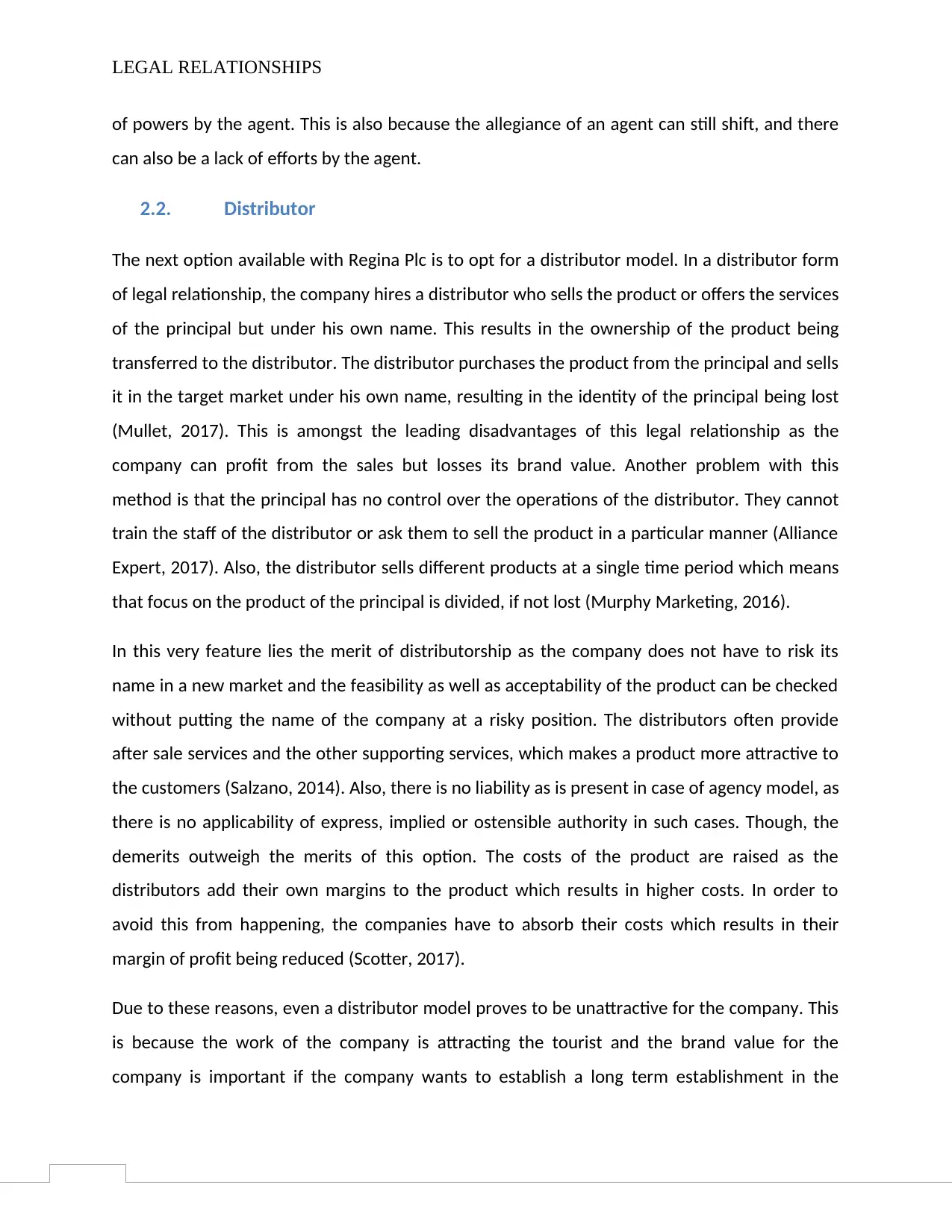
LEGAL RELATIONSHIPS
of powers by the agent. This is also because the allegiance of an agent can still shift, and there
can also be a lack of efforts by the agent.
2.2. Distributor
The next option available with Regina Plc is to opt for a distributor model. In a distributor form
of legal relationship, the company hires a distributor who sells the product or offers the services
of the principal but under his own name. This results in the ownership of the product being
transferred to the distributor. The distributor purchases the product from the principal and sells
it in the target market under his own name, resulting in the identity of the principal being lost
(Mullet, 2017). This is amongst the leading disadvantages of this legal relationship as the
company can profit from the sales but losses its brand value. Another problem with this
method is that the principal has no control over the operations of the distributor. They cannot
train the staff of the distributor or ask them to sell the product in a particular manner (Alliance
Expert, 2017). Also, the distributor sells different products at a single time period which means
that focus on the product of the principal is divided, if not lost (Murphy Marketing, 2016).
In this very feature lies the merit of distributorship as the company does not have to risk its
name in a new market and the feasibility as well as acceptability of the product can be checked
without putting the name of the company at a risky position. The distributors often provide
after sale services and the other supporting services, which makes a product more attractive to
the customers (Salzano, 2014). Also, there is no liability as is present in case of agency model, as
there is no applicability of express, implied or ostensible authority in such cases. Though, the
demerits outweigh the merits of this option. The costs of the product are raised as the
distributors add their own margins to the product which results in higher costs. In order to
avoid this from happening, the companies have to absorb their costs which results in their
margin of profit being reduced (Scotter, 2017).
Due to these reasons, even a distributor model proves to be unattractive for the company. This
is because the work of the company is attracting the tourist and the brand value for the
company is important if the company wants to establish a long term establishment in the
of powers by the agent. This is also because the allegiance of an agent can still shift, and there
can also be a lack of efforts by the agent.
2.2. Distributor
The next option available with Regina Plc is to opt for a distributor model. In a distributor form
of legal relationship, the company hires a distributor who sells the product or offers the services
of the principal but under his own name. This results in the ownership of the product being
transferred to the distributor. The distributor purchases the product from the principal and sells
it in the target market under his own name, resulting in the identity of the principal being lost
(Mullet, 2017). This is amongst the leading disadvantages of this legal relationship as the
company can profit from the sales but losses its brand value. Another problem with this
method is that the principal has no control over the operations of the distributor. They cannot
train the staff of the distributor or ask them to sell the product in a particular manner (Alliance
Expert, 2017). Also, the distributor sells different products at a single time period which means
that focus on the product of the principal is divided, if not lost (Murphy Marketing, 2016).
In this very feature lies the merit of distributorship as the company does not have to risk its
name in a new market and the feasibility as well as acceptability of the product can be checked
without putting the name of the company at a risky position. The distributors often provide
after sale services and the other supporting services, which makes a product more attractive to
the customers (Salzano, 2014). Also, there is no liability as is present in case of agency model, as
there is no applicability of express, implied or ostensible authority in such cases. Though, the
demerits outweigh the merits of this option. The costs of the product are raised as the
distributors add their own margins to the product which results in higher costs. In order to
avoid this from happening, the companies have to absorb their costs which results in their
margin of profit being reduced (Scotter, 2017).
Due to these reasons, even a distributor model proves to be unattractive for the company. This
is because the work of the company is attracting the tourist and the brand value for the
company is important if the company wants to establish a long term establishment in the
⊘ This is a preview!⊘
Do you want full access?
Subscribe today to unlock all pages.

Trusted by 1+ million students worldwide
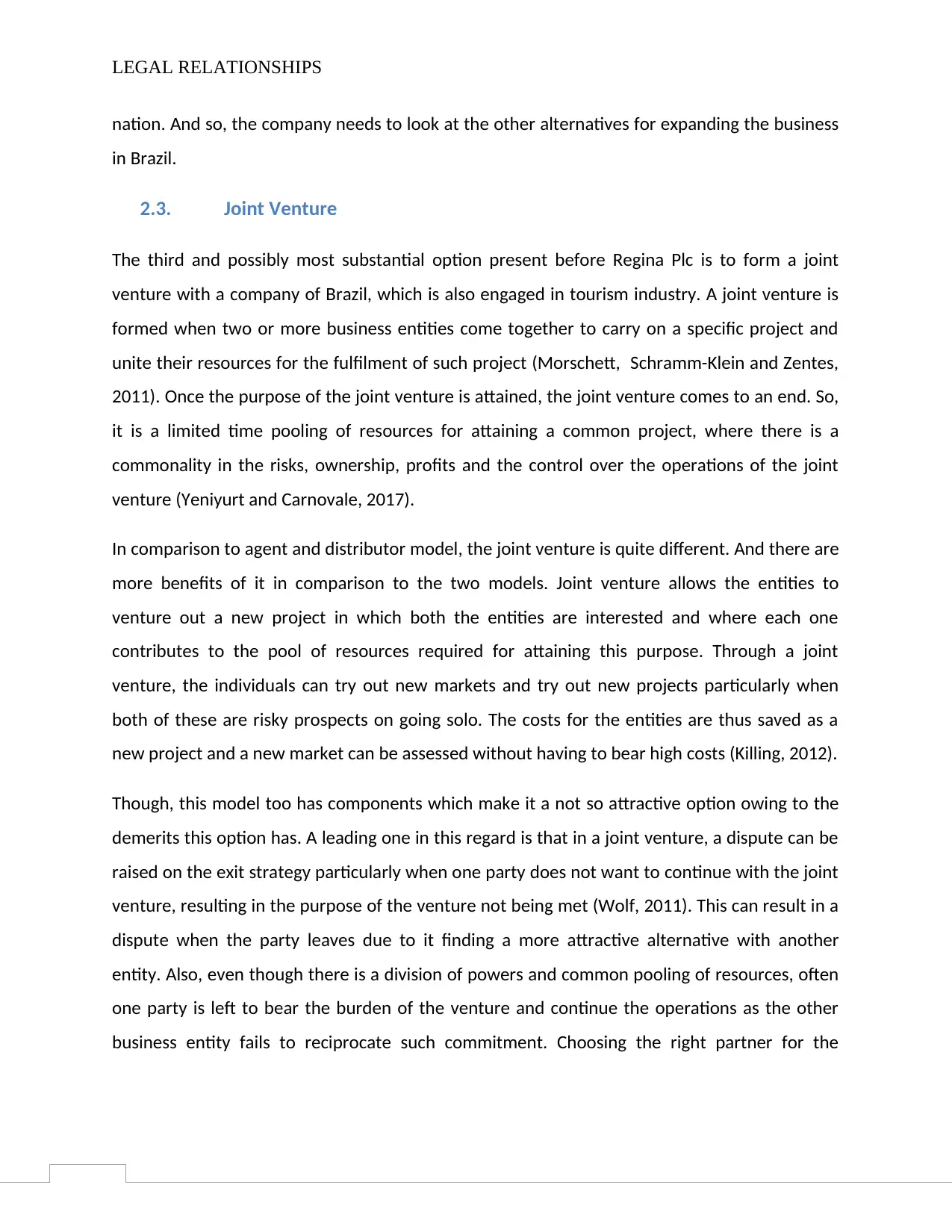
LEGAL RELATIONSHIPS
nation. And so, the company needs to look at the other alternatives for expanding the business
in Brazil.
2.3. Joint Venture
The third and possibly most substantial option present before Regina Plc is to form a joint
venture with a company of Brazil, which is also engaged in tourism industry. A joint venture is
formed when two or more business entities come together to carry on a specific project and
unite their resources for the fulfilment of such project (Morschett, Schramm-Klein and Zentes,
2011). Once the purpose of the joint venture is attained, the joint venture comes to an end. So,
it is a limited time pooling of resources for attaining a common project, where there is a
commonality in the risks, ownership, profits and the control over the operations of the joint
venture (Yeniyurt and Carnovale, 2017).
In comparison to agent and distributor model, the joint venture is quite different. And there are
more benefits of it in comparison to the two models. Joint venture allows the entities to
venture out a new project in which both the entities are interested and where each one
contributes to the pool of resources required for attaining this purpose. Through a joint
venture, the individuals can try out new markets and try out new projects particularly when
both of these are risky prospects on going solo. The costs for the entities are thus saved as a
new project and a new market can be assessed without having to bear high costs (Killing, 2012).
Though, this model too has components which make it a not so attractive option owing to the
demerits this option has. A leading one in this regard is that in a joint venture, a dispute can be
raised on the exit strategy particularly when one party does not want to continue with the joint
venture, resulting in the purpose of the venture not being met (Wolf, 2011). This can result in a
dispute when the party leaves due to it finding a more attractive alternative with another
entity. Also, even though there is a division of powers and common pooling of resources, often
one party is left to bear the burden of the venture and continue the operations as the other
business entity fails to reciprocate such commitment. Choosing the right partner for the
nation. And so, the company needs to look at the other alternatives for expanding the business
in Brazil.
2.3. Joint Venture
The third and possibly most substantial option present before Regina Plc is to form a joint
venture with a company of Brazil, which is also engaged in tourism industry. A joint venture is
formed when two or more business entities come together to carry on a specific project and
unite their resources for the fulfilment of such project (Morschett, Schramm-Klein and Zentes,
2011). Once the purpose of the joint venture is attained, the joint venture comes to an end. So,
it is a limited time pooling of resources for attaining a common project, where there is a
commonality in the risks, ownership, profits and the control over the operations of the joint
venture (Yeniyurt and Carnovale, 2017).
In comparison to agent and distributor model, the joint venture is quite different. And there are
more benefits of it in comparison to the two models. Joint venture allows the entities to
venture out a new project in which both the entities are interested and where each one
contributes to the pool of resources required for attaining this purpose. Through a joint
venture, the individuals can try out new markets and try out new projects particularly when
both of these are risky prospects on going solo. The costs for the entities are thus saved as a
new project and a new market can be assessed without having to bear high costs (Killing, 2012).
Though, this model too has components which make it a not so attractive option owing to the
demerits this option has. A leading one in this regard is that in a joint venture, a dispute can be
raised on the exit strategy particularly when one party does not want to continue with the joint
venture, resulting in the purpose of the venture not being met (Wolf, 2011). This can result in a
dispute when the party leaves due to it finding a more attractive alternative with another
entity. Also, even though there is a division of powers and common pooling of resources, often
one party is left to bear the burden of the venture and continue the operations as the other
business entity fails to reciprocate such commitment. Choosing the right partner for the
Paraphrase This Document
Need a fresh take? Get an instant paraphrase of this document with our AI Paraphraser
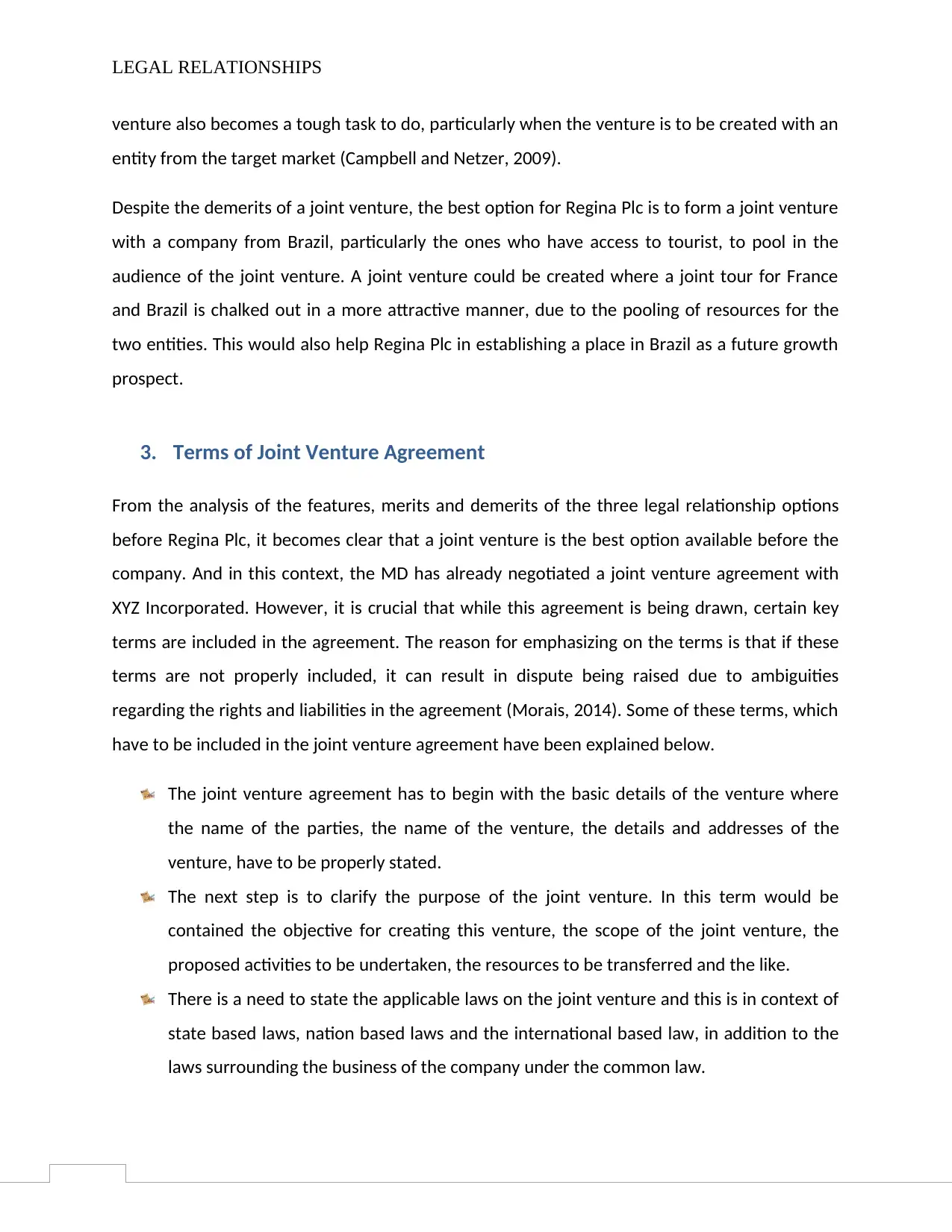
LEGAL RELATIONSHIPS
venture also becomes a tough task to do, particularly when the venture is to be created with an
entity from the target market (Campbell and Netzer, 2009).
Despite the demerits of a joint venture, the best option for Regina Plc is to form a joint venture
with a company from Brazil, particularly the ones who have access to tourist, to pool in the
audience of the joint venture. A joint venture could be created where a joint tour for France
and Brazil is chalked out in a more attractive manner, due to the pooling of resources for the
two entities. This would also help Regina Plc in establishing a place in Brazil as a future growth
prospect.
3. Terms of Joint Venture Agreement
From the analysis of the features, merits and demerits of the three legal relationship options
before Regina Plc, it becomes clear that a joint venture is the best option available before the
company. And in this context, the MD has already negotiated a joint venture agreement with
XYZ Incorporated. However, it is crucial that while this agreement is being drawn, certain key
terms are included in the agreement. The reason for emphasizing on the terms is that if these
terms are not properly included, it can result in dispute being raised due to ambiguities
regarding the rights and liabilities in the agreement (Morais, 2014). Some of these terms, which
have to be included in the joint venture agreement have been explained below.
The joint venture agreement has to begin with the basic details of the venture where
the name of the parties, the name of the venture, the details and addresses of the
venture, have to be properly stated.
The next step is to clarify the purpose of the joint venture. In this term would be
contained the objective for creating this venture, the scope of the joint venture, the
proposed activities to be undertaken, the resources to be transferred and the like.
There is a need to state the applicable laws on the joint venture and this is in context of
state based laws, nation based laws and the international based law, in addition to the
laws surrounding the business of the company under the common law.
venture also becomes a tough task to do, particularly when the venture is to be created with an
entity from the target market (Campbell and Netzer, 2009).
Despite the demerits of a joint venture, the best option for Regina Plc is to form a joint venture
with a company from Brazil, particularly the ones who have access to tourist, to pool in the
audience of the joint venture. A joint venture could be created where a joint tour for France
and Brazil is chalked out in a more attractive manner, due to the pooling of resources for the
two entities. This would also help Regina Plc in establishing a place in Brazil as a future growth
prospect.
3. Terms of Joint Venture Agreement
From the analysis of the features, merits and demerits of the three legal relationship options
before Regina Plc, it becomes clear that a joint venture is the best option available before the
company. And in this context, the MD has already negotiated a joint venture agreement with
XYZ Incorporated. However, it is crucial that while this agreement is being drawn, certain key
terms are included in the agreement. The reason for emphasizing on the terms is that if these
terms are not properly included, it can result in dispute being raised due to ambiguities
regarding the rights and liabilities in the agreement (Morais, 2014). Some of these terms, which
have to be included in the joint venture agreement have been explained below.
The joint venture agreement has to begin with the basic details of the venture where
the name of the parties, the name of the venture, the details and addresses of the
venture, have to be properly stated.
The next step is to clarify the purpose of the joint venture. In this term would be
contained the objective for creating this venture, the scope of the joint venture, the
proposed activities to be undertaken, the resources to be transferred and the like.
There is a need to state the applicable laws on the joint venture and this is in context of
state based laws, nation based laws and the international based law, in addition to the
laws surrounding the business of the company under the common law.
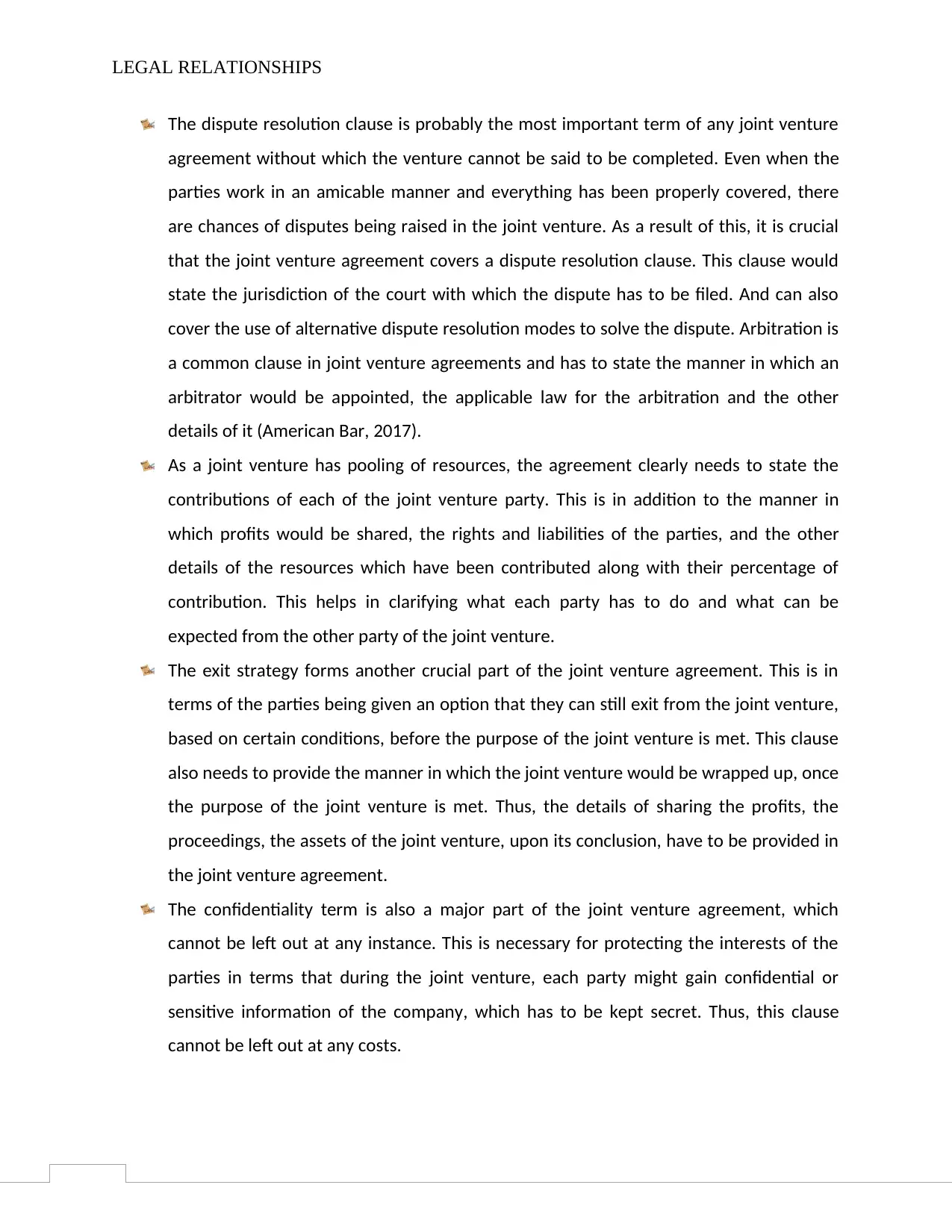
LEGAL RELATIONSHIPS
The dispute resolution clause is probably the most important term of any joint venture
agreement without which the venture cannot be said to be completed. Even when the
parties work in an amicable manner and everything has been properly covered, there
are chances of disputes being raised in the joint venture. As a result of this, it is crucial
that the joint venture agreement covers a dispute resolution clause. This clause would
state the jurisdiction of the court with which the dispute has to be filed. And can also
cover the use of alternative dispute resolution modes to solve the dispute. Arbitration is
a common clause in joint venture agreements and has to state the manner in which an
arbitrator would be appointed, the applicable law for the arbitration and the other
details of it (American Bar, 2017).
As a joint venture has pooling of resources, the agreement clearly needs to state the
contributions of each of the joint venture party. This is in addition to the manner in
which profits would be shared, the rights and liabilities of the parties, and the other
details of the resources which have been contributed along with their percentage of
contribution. This helps in clarifying what each party has to do and what can be
expected from the other party of the joint venture.
The exit strategy forms another crucial part of the joint venture agreement. This is in
terms of the parties being given an option that they can still exit from the joint venture,
based on certain conditions, before the purpose of the joint venture is met. This clause
also needs to provide the manner in which the joint venture would be wrapped up, once
the purpose of the joint venture is met. Thus, the details of sharing the profits, the
proceedings, the assets of the joint venture, upon its conclusion, have to be provided in
the joint venture agreement.
The confidentiality term is also a major part of the joint venture agreement, which
cannot be left out at any instance. This is necessary for protecting the interests of the
parties in terms that during the joint venture, each party might gain confidential or
sensitive information of the company, which has to be kept secret. Thus, this clause
cannot be left out at any costs.
The dispute resolution clause is probably the most important term of any joint venture
agreement without which the venture cannot be said to be completed. Even when the
parties work in an amicable manner and everything has been properly covered, there
are chances of disputes being raised in the joint venture. As a result of this, it is crucial
that the joint venture agreement covers a dispute resolution clause. This clause would
state the jurisdiction of the court with which the dispute has to be filed. And can also
cover the use of alternative dispute resolution modes to solve the dispute. Arbitration is
a common clause in joint venture agreements and has to state the manner in which an
arbitrator would be appointed, the applicable law for the arbitration and the other
details of it (American Bar, 2017).
As a joint venture has pooling of resources, the agreement clearly needs to state the
contributions of each of the joint venture party. This is in addition to the manner in
which profits would be shared, the rights and liabilities of the parties, and the other
details of the resources which have been contributed along with their percentage of
contribution. This helps in clarifying what each party has to do and what can be
expected from the other party of the joint venture.
The exit strategy forms another crucial part of the joint venture agreement. This is in
terms of the parties being given an option that they can still exit from the joint venture,
based on certain conditions, before the purpose of the joint venture is met. This clause
also needs to provide the manner in which the joint venture would be wrapped up, once
the purpose of the joint venture is met. Thus, the details of sharing the profits, the
proceedings, the assets of the joint venture, upon its conclusion, have to be provided in
the joint venture agreement.
The confidentiality term is also a major part of the joint venture agreement, which
cannot be left out at any instance. This is necessary for protecting the interests of the
parties in terms that during the joint venture, each party might gain confidential or
sensitive information of the company, which has to be kept secret. Thus, this clause
cannot be left out at any costs.
⊘ This is a preview!⊘
Do you want full access?
Subscribe today to unlock all pages.

Trusted by 1+ million students worldwide
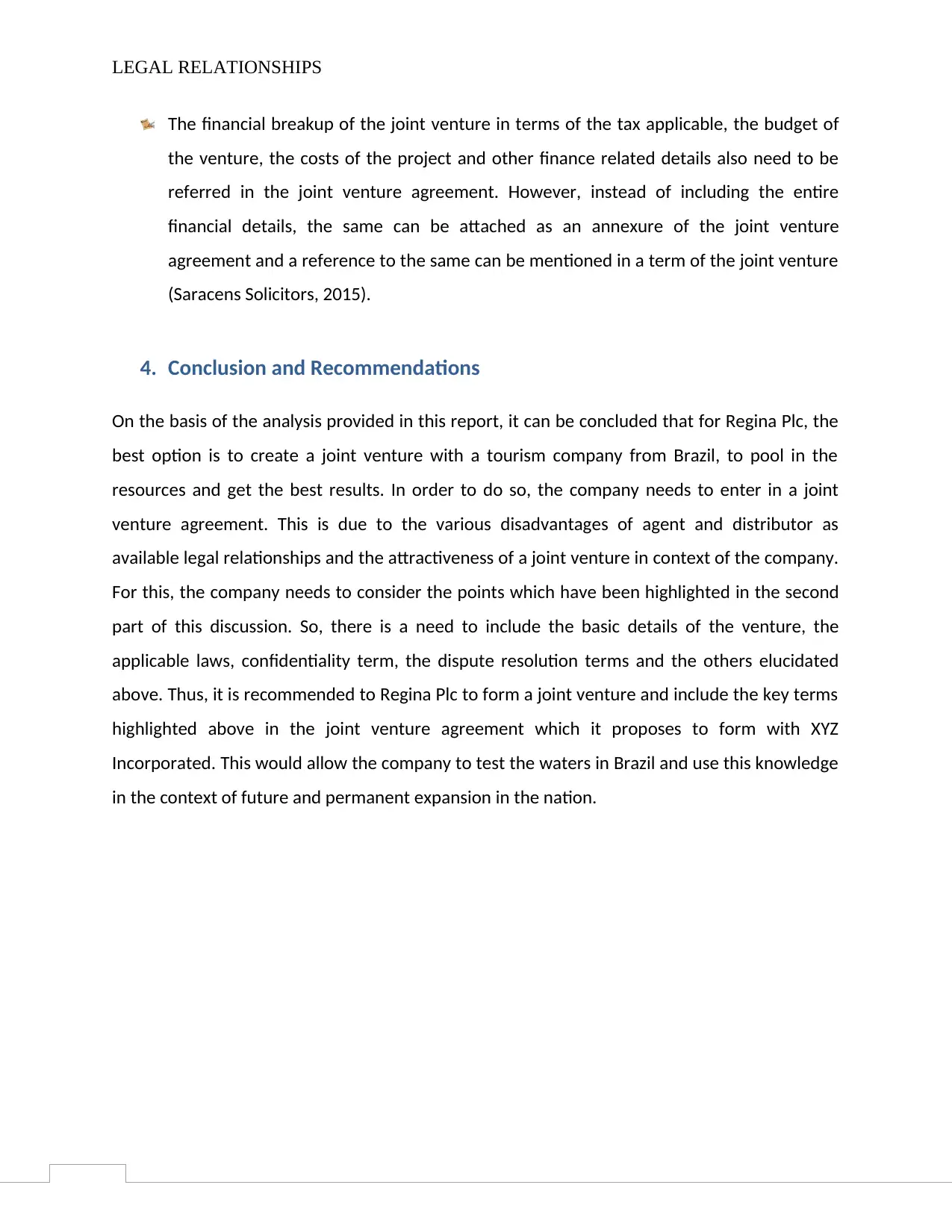
LEGAL RELATIONSHIPS
The financial breakup of the joint venture in terms of the tax applicable, the budget of
the venture, the costs of the project and other finance related details also need to be
referred in the joint venture agreement. However, instead of including the entire
financial details, the same can be attached as an annexure of the joint venture
agreement and a reference to the same can be mentioned in a term of the joint venture
(Saracens Solicitors, 2015).
4. Conclusion and Recommendations
On the basis of the analysis provided in this report, it can be concluded that for Regina Plc, the
best option is to create a joint venture with a tourism company from Brazil, to pool in the
resources and get the best results. In order to do so, the company needs to enter in a joint
venture agreement. This is due to the various disadvantages of agent and distributor as
available legal relationships and the attractiveness of a joint venture in context of the company.
For this, the company needs to consider the points which have been highlighted in the second
part of this discussion. So, there is a need to include the basic details of the venture, the
applicable laws, confidentiality term, the dispute resolution terms and the others elucidated
above. Thus, it is recommended to Regina Plc to form a joint venture and include the key terms
highlighted above in the joint venture agreement which it proposes to form with XYZ
Incorporated. This would allow the company to test the waters in Brazil and use this knowledge
in the context of future and permanent expansion in the nation.
The financial breakup of the joint venture in terms of the tax applicable, the budget of
the venture, the costs of the project and other finance related details also need to be
referred in the joint venture agreement. However, instead of including the entire
financial details, the same can be attached as an annexure of the joint venture
agreement and a reference to the same can be mentioned in a term of the joint venture
(Saracens Solicitors, 2015).
4. Conclusion and Recommendations
On the basis of the analysis provided in this report, it can be concluded that for Regina Plc, the
best option is to create a joint venture with a tourism company from Brazil, to pool in the
resources and get the best results. In order to do so, the company needs to enter in a joint
venture agreement. This is due to the various disadvantages of agent and distributor as
available legal relationships and the attractiveness of a joint venture in context of the company.
For this, the company needs to consider the points which have been highlighted in the second
part of this discussion. So, there is a need to include the basic details of the venture, the
applicable laws, confidentiality term, the dispute resolution terms and the others elucidated
above. Thus, it is recommended to Regina Plc to form a joint venture and include the key terms
highlighted above in the joint venture agreement which it proposes to form with XYZ
Incorporated. This would allow the company to test the waters in Brazil and use this knowledge
in the context of future and permanent expansion in the nation.
Paraphrase This Document
Need a fresh take? Get an instant paraphrase of this document with our AI Paraphraser
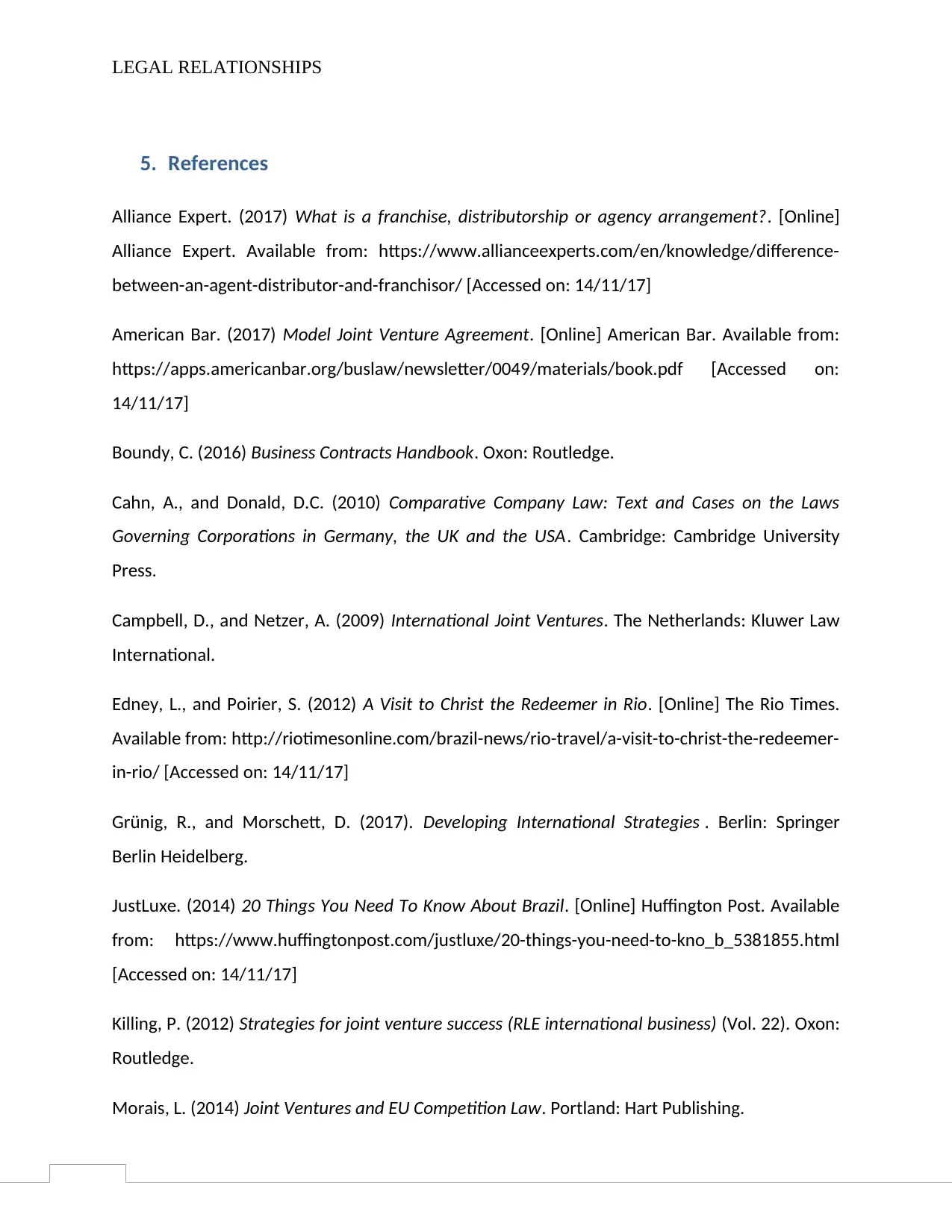
LEGAL RELATIONSHIPS
5. References
Alliance Expert. (2017) What is a franchise, distributorship or agency arrangement?. [Online]
Alliance Expert. Available from: https://www.allianceexperts.com/en/knowledge/difference-
between-an-agent-distributor-and-franchisor/ [Accessed on: 14/11/17]
American Bar. (2017) Model Joint Venture Agreement. [Online] American Bar. Available from:
https://apps.americanbar.org/buslaw/newsletter/0049/materials/book.pdf [Accessed on:
14/11/17]
Boundy, C. (2016) Business Contracts Handbook. Oxon: Routledge.
Cahn, A., and Donald, D.C. (2010) Comparative Company Law: Text and Cases on the Laws
Governing Corporations in Germany, the UK and the USA. Cambridge: Cambridge University
Press.
Campbell, D., and Netzer, A. (2009) International Joint Ventures. The Netherlands: Kluwer Law
International.
Edney, L., and Poirier, S. (2012) A Visit to Christ the Redeemer in Rio. [Online] The Rio Times.
Available from: http://riotimesonline.com/brazil-news/rio-travel/a-visit-to-christ-the-redeemer-
in-rio/ [Accessed on: 14/11/17]
Grünig, R., and Morschett, D. (2017). Developing International Strategies . Berlin: Springer
Berlin Heidelberg.
JustLuxe. (2014) 20 Things You Need To Know About Brazil. [Online] Huffington Post. Available
from: https://www.huffingtonpost.com/justluxe/20-things-you-need-to-kno_b_5381855.html
[Accessed on: 14/11/17]
Killing, P. (2012) Strategies for joint venture success (RLE international business) (Vol. 22). Oxon:
Routledge.
Morais, L. (2014) Joint Ventures and EU Competition Law. Portland: Hart Publishing.
5. References
Alliance Expert. (2017) What is a franchise, distributorship or agency arrangement?. [Online]
Alliance Expert. Available from: https://www.allianceexperts.com/en/knowledge/difference-
between-an-agent-distributor-and-franchisor/ [Accessed on: 14/11/17]
American Bar. (2017) Model Joint Venture Agreement. [Online] American Bar. Available from:
https://apps.americanbar.org/buslaw/newsletter/0049/materials/book.pdf [Accessed on:
14/11/17]
Boundy, C. (2016) Business Contracts Handbook. Oxon: Routledge.
Cahn, A., and Donald, D.C. (2010) Comparative Company Law: Text and Cases on the Laws
Governing Corporations in Germany, the UK and the USA. Cambridge: Cambridge University
Press.
Campbell, D., and Netzer, A. (2009) International Joint Ventures. The Netherlands: Kluwer Law
International.
Edney, L., and Poirier, S. (2012) A Visit to Christ the Redeemer in Rio. [Online] The Rio Times.
Available from: http://riotimesonline.com/brazil-news/rio-travel/a-visit-to-christ-the-redeemer-
in-rio/ [Accessed on: 14/11/17]
Grünig, R., and Morschett, D. (2017). Developing International Strategies . Berlin: Springer
Berlin Heidelberg.
JustLuxe. (2014) 20 Things You Need To Know About Brazil. [Online] Huffington Post. Available
from: https://www.huffingtonpost.com/justluxe/20-things-you-need-to-kno_b_5381855.html
[Accessed on: 14/11/17]
Killing, P. (2012) Strategies for joint venture success (RLE international business) (Vol. 22). Oxon:
Routledge.
Morais, L. (2014) Joint Ventures and EU Competition Law. Portland: Hart Publishing.
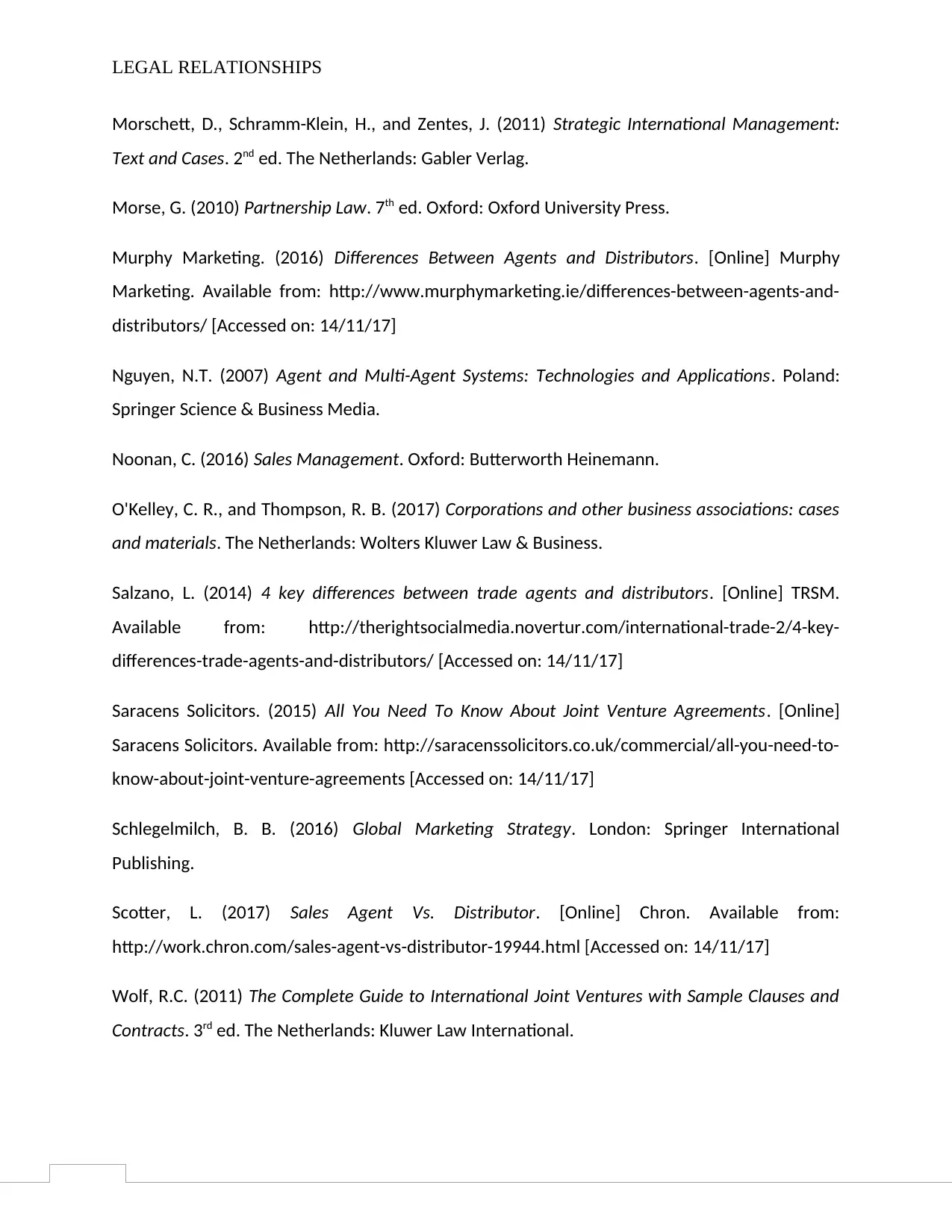
LEGAL RELATIONSHIPS
Morschett, D., Schramm-Klein, H., and Zentes, J. (2011) Strategic International Management:
Text and Cases. 2nd ed. The Netherlands: Gabler Verlag.
Morse, G. (2010) Partnership Law. 7th ed. Oxford: Oxford University Press.
Murphy Marketing. (2016) Differences Between Agents and Distributors. [Online] Murphy
Marketing. Available from: http://www.murphymarketing.ie/differences-between-agents-and-
distributors/ [Accessed on: 14/11/17]
Nguyen, N.T. (2007) Agent and Multi-Agent Systems: Technologies and Applications. Poland:
Springer Science & Business Media.
Noonan, C. (2016) Sales Management. Oxford: Butterworth Heinemann.
O'Kelley, C. R., and Thompson, R. B. (2017) Corporations and other business associations: cases
and materials. The Netherlands: Wolters Kluwer Law & Business.
Salzano, L. (2014) 4 key differences between trade agents and distributors. [Online] TRSM.
Available from: http://therightsocialmedia.novertur.com/international-trade-2/4-key-
differences-trade-agents-and-distributors/ [Accessed on: 14/11/17]
Saracens Solicitors. (2015) All You Need To Know About Joint Venture Agreements. [Online]
Saracens Solicitors. Available from: http://saracenssolicitors.co.uk/commercial/all-you-need-to-
know-about-joint-venture-agreements [Accessed on: 14/11/17]
Schlegelmilch, B. B. (2016) Global Marketing Strategy. London: Springer International
Publishing.
Scotter, L. (2017) Sales Agent Vs. Distributor. [Online] Chron. Available from:
http://work.chron.com/sales-agent-vs-distributor-19944.html [Accessed on: 14/11/17]
Wolf, R.C. (2011) The Complete Guide to International Joint Ventures with Sample Clauses and
Contracts. 3rd ed. The Netherlands: Kluwer Law International.
Morschett, D., Schramm-Klein, H., and Zentes, J. (2011) Strategic International Management:
Text and Cases. 2nd ed. The Netherlands: Gabler Verlag.
Morse, G. (2010) Partnership Law. 7th ed. Oxford: Oxford University Press.
Murphy Marketing. (2016) Differences Between Agents and Distributors. [Online] Murphy
Marketing. Available from: http://www.murphymarketing.ie/differences-between-agents-and-
distributors/ [Accessed on: 14/11/17]
Nguyen, N.T. (2007) Agent and Multi-Agent Systems: Technologies and Applications. Poland:
Springer Science & Business Media.
Noonan, C. (2016) Sales Management. Oxford: Butterworth Heinemann.
O'Kelley, C. R., and Thompson, R. B. (2017) Corporations and other business associations: cases
and materials. The Netherlands: Wolters Kluwer Law & Business.
Salzano, L. (2014) 4 key differences between trade agents and distributors. [Online] TRSM.
Available from: http://therightsocialmedia.novertur.com/international-trade-2/4-key-
differences-trade-agents-and-distributors/ [Accessed on: 14/11/17]
Saracens Solicitors. (2015) All You Need To Know About Joint Venture Agreements. [Online]
Saracens Solicitors. Available from: http://saracenssolicitors.co.uk/commercial/all-you-need-to-
know-about-joint-venture-agreements [Accessed on: 14/11/17]
Schlegelmilch, B. B. (2016) Global Marketing Strategy. London: Springer International
Publishing.
Scotter, L. (2017) Sales Agent Vs. Distributor. [Online] Chron. Available from:
http://work.chron.com/sales-agent-vs-distributor-19944.html [Accessed on: 14/11/17]
Wolf, R.C. (2011) The Complete Guide to International Joint Ventures with Sample Clauses and
Contracts. 3rd ed. The Netherlands: Kluwer Law International.
⊘ This is a preview!⊘
Do you want full access?
Subscribe today to unlock all pages.

Trusted by 1+ million students worldwide
1 out of 13
Your All-in-One AI-Powered Toolkit for Academic Success.
+13062052269
info@desklib.com
Available 24*7 on WhatsApp / Email
![[object Object]](/_next/static/media/star-bottom.7253800d.svg)
Unlock your academic potential
Copyright © 2020–2025 A2Z Services. All Rights Reserved. Developed and managed by ZUCOL.


